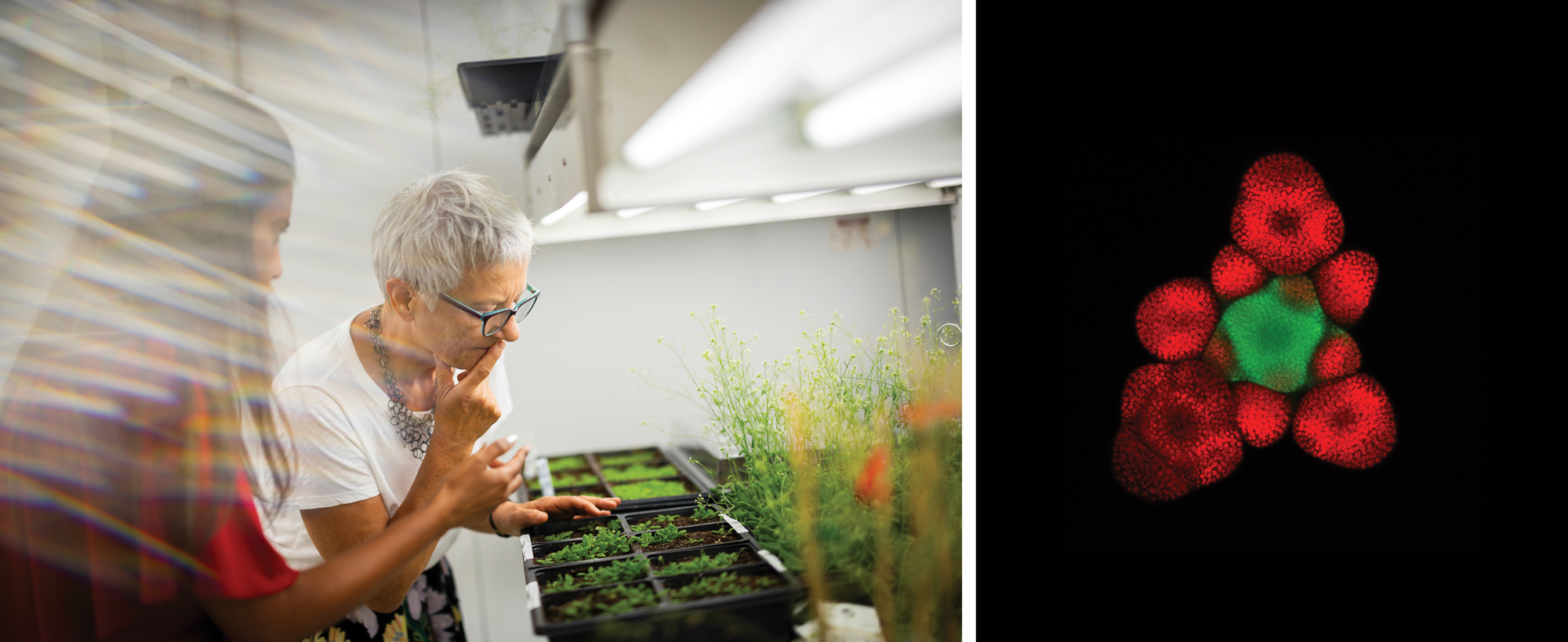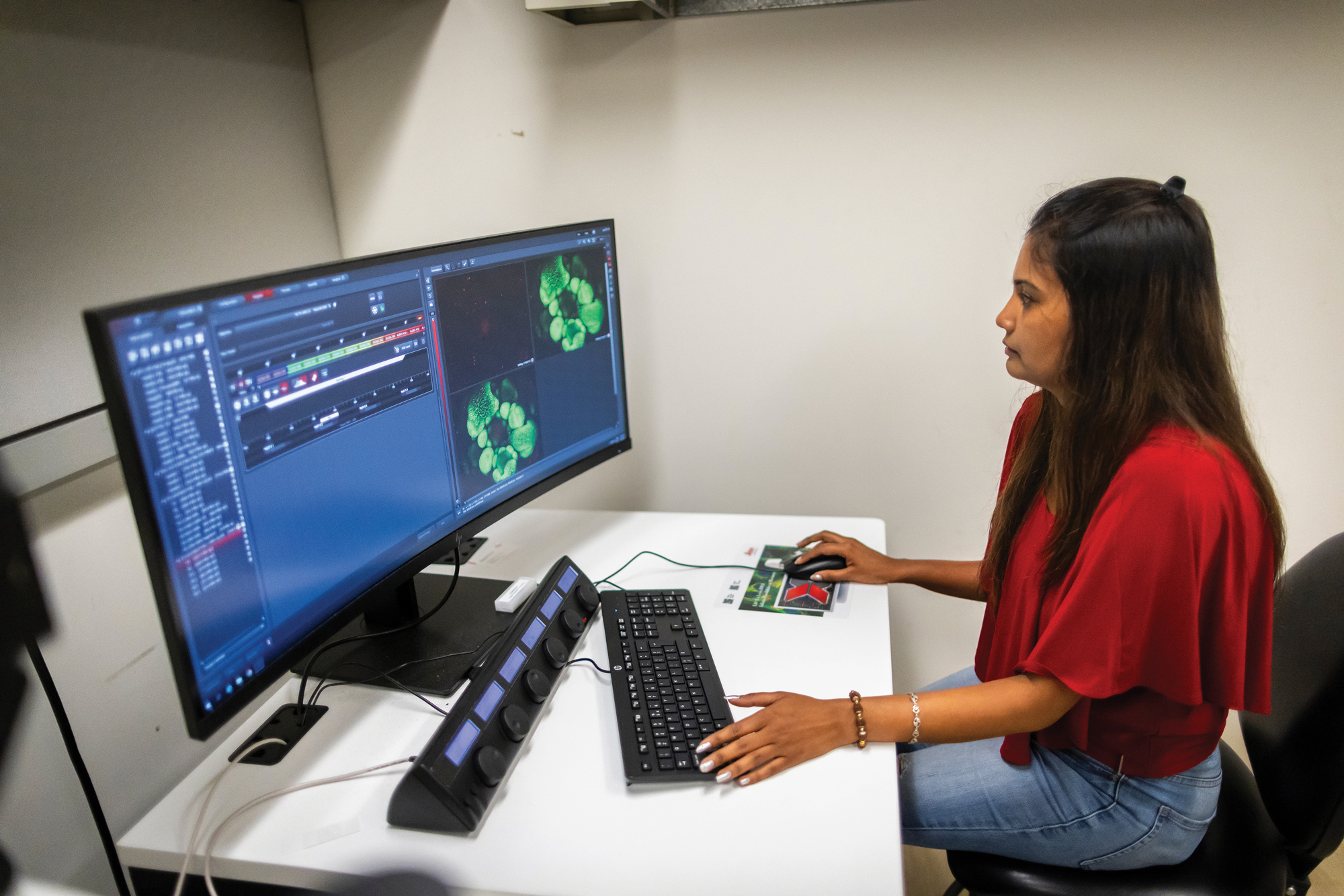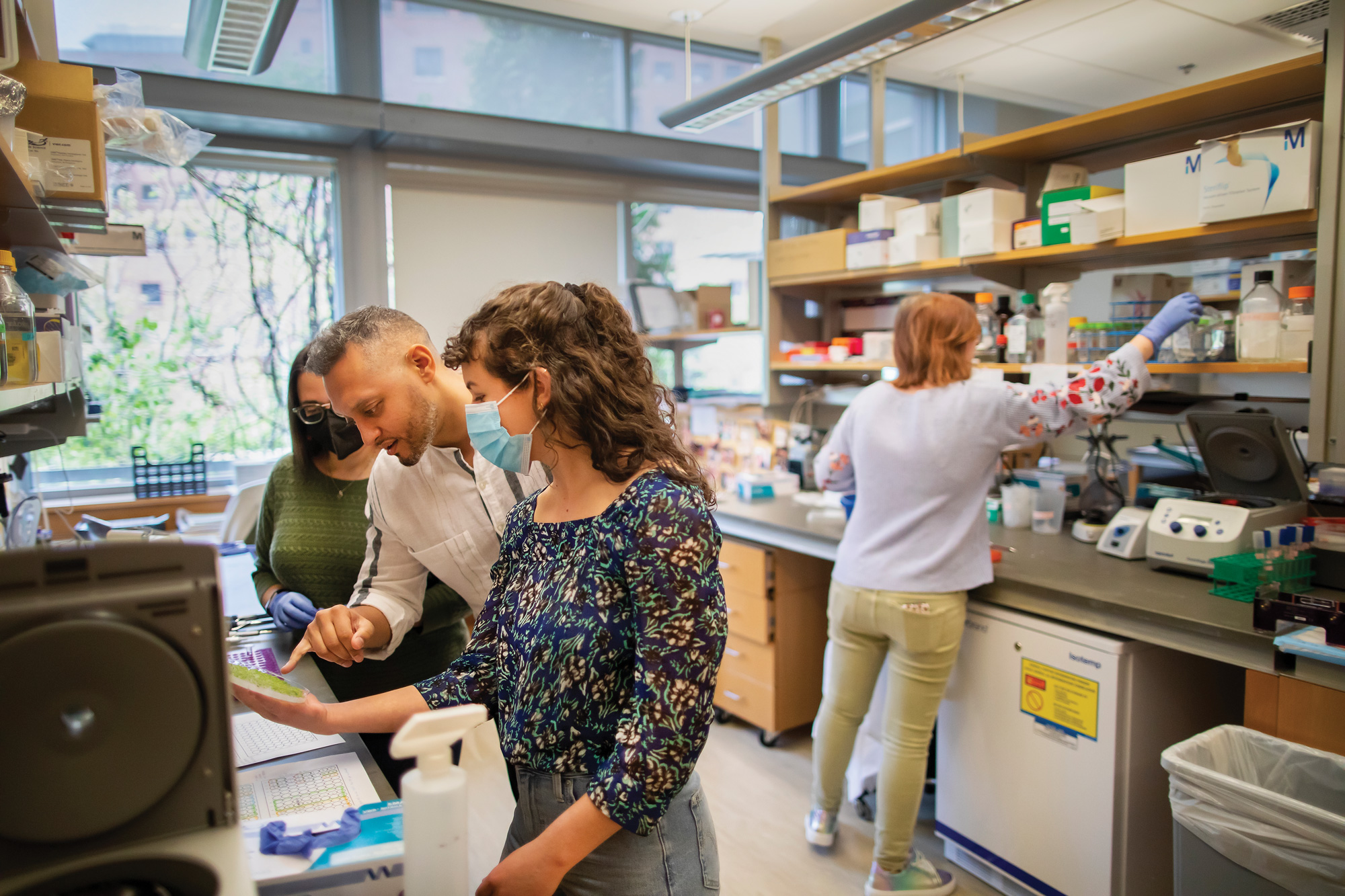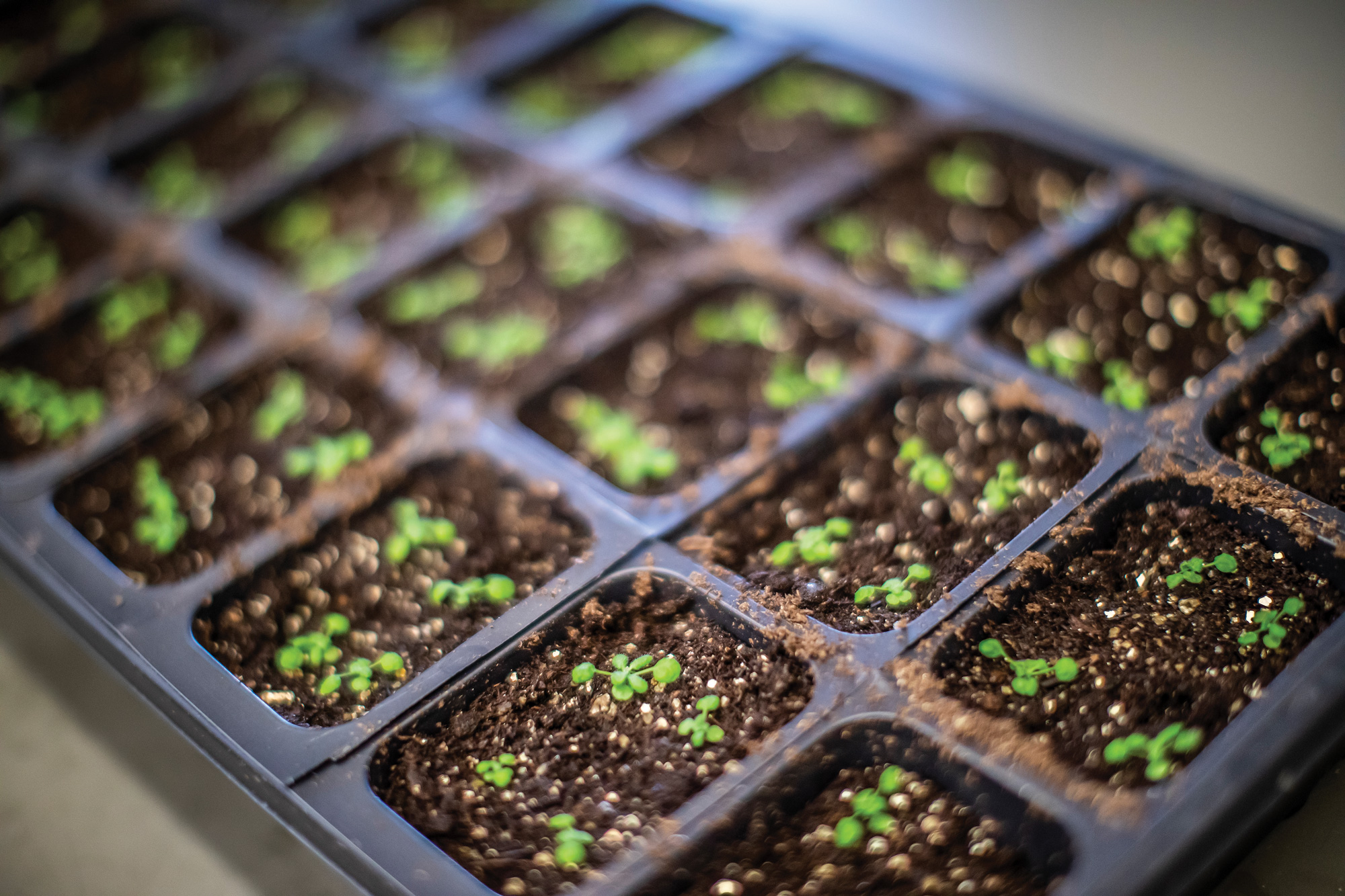Cultivating Discovery
Within the Department of Biology, the self-described “plant group” is employing cutting-edge techniques to explore everything from cancer and developmental biology to how agricultural crops might withstand a changing climate.

Many scientists looking for a cancer cure use cells lines or animal models to ply their trade. The same goes for researchers interested in how organisms develop or respond to stress. But what if they want to observe these processes over and over, in a whole, living organism that’s inexpensive to maintain and bears similarities to human biology?
Then they might look to plants.
In the Department of Biology, the self-described “plant group”—seven current faculty and numerous grad students and postdocs—knows this well. Though the group’s strength, breadth, and depth distinguish it from most of its peers, its research has stayed under the radar. With plans to accelerate work in stress response and centralize efforts to wield plants as tools in the battle against climate change, however, the plant group’s quiet strength may not stay quiet for long.
“During the food crisis of the 1970s, plant science took off,” says Scott Poethig, John H. and Margaret B. Fassitt Professor of Biology. “It was all about, how can we help the world feed itself? And that’s still one way plant biologists justify their work. But now I would argue, it’s less in terms of our impact on the food system and more in terms of our impact on the environment. What we do is relevant in terms of climate change, too.”
At Penn, plant biologists are leveraging the latest scientific techniques and high-tech growth facilities to elucidate the inner workings of plants. The insights they’re developing not only satisfy researchers’ love of discovery and their innate curiosity about and appreciation of the natural world—they may just save humanity.
The Power of Plants
It’s no accident that numerous seminal biological discoveries have occurred in plants. The concept of heredity emerged, famously, in the 19th century from experiments in pea plants by none other than Gregor Mendel. When Kimberly Gallagher, Professor and Chair, teaches her introductory molecular biology and genetics course, she always returns to an original line in Mendel’s publications.
“He was convinced that the same essential laws that apply to plants apply to all organisms,” she says. “Every time I read that and think about the time he was coming from, I just think, ‘That guy was my man.’ How audacious that he thought he was going to be able to figure out essential laws of all organisms by studying plants. And to my mind, he was largely correct. Maybe it’s my bias, but I see plants as a superior organism for studying plasticity, development, for pursuing these kinds of questions.”
Biased or not, some members of the plant group have a deep and abiding love of plants. Others came upon them as a useful biological model. What unites these researchers is a sense that plants, though they cannot move of their own accord and lack the recognizable features that mammalian model organisms possess, nevertheless harbor the keys to unlocking a plethora of scientific mysteries.
Doris Wagner has a seemingly innate passion for plants. The DiMaura Professor of Biology launched her scientific career after apprenticing on a farm, and today enjoys timing hikes to the emergence of certain flowering spring ephemerals, native species that bloom for a brief period before dying back and making way for other species’ growth.
“I never even considered studying anything else,” Wagner says. “I feel that plants are, as multicellular terrestrial organisms, the most adaptable—they can live in so many different environments, from no light to extreme heat to extreme cold. Almost anywhere you go you will find plants. I’ve always thought that was fantastic, and that’s still something we study, this amazing plasticity and ability to reprogram themselves.”
That pull of plants and the natural world is shared by Addison Buxton-Martin, a fourth-year graduate student in the lab of Assistant Professor Corlett Wood. “I was one of those kids who had all these bug collections,” he says. In college, he says he found himself gravitating toward plants.
“Imagine if you had to stand in one spot day in and day out and experience all of these changes in your environment,” he says, like the comings and goings of other organisms or the whims of the weather. “Asking the question, in some sense, of ‘What is it like to be a plant?’ sparked my interest and led me down a path of realizing that plants are really cool.”
Plants also hooked Professor Brent Helliker during college, when the then-English major found himself excelling in a biology course he’d taken on a whim. “The plant part of the course just blew me away,” he says. “I became fascinated by these strange organisms.” For Professor Brian Gregory, plants appeal on a more practical level. “We’re able to study these processes of interest in a growing, developing, responding organism on a whole-organism scale,” he says.
Anyone who has ever grown plants from seed can understand their suitability as a model for studying development. “For mammals, you’re in utero and you make these organs and you’re done,” says Aman Husbands, Mitchell J. Blutt and Margo Krody Blutt Presidential Assistant Professor of Biology. “But in plants, you can study how they produce leaf after leaf after leaf and then how they switch to make flowers. It’s just a really powerful system.”
Carrying Forward a Legacy
In many ways it’s appropriate that Penn is a hub for important plant biology research, as Philadelphia’s reputation for plant science dates back three centuries, to a time when the city was emerging as an intellectual center for botanists. Plant collectors like John Bartram and William Hamilton established famed gardens with robust collections, while Thomas Jefferson had plant specimens from Meriwether Lewis and William Clark’s expeditions sent back to Philadelphia, where they still reside at the Drexel University Academy of Natural Sciences. At Penn specifically, the late 18th and early 19th centuries saw noted figures like botanists Benjamin Smith Barton and Thomas Nuttall greatly expand plant knowledge in their time.
The origins of the Department of Biology itself have roots (pun intended) in plant biology. In the 1950s, the departments of botany, microbiology, and zoology merged to form the Department of Biology, spurred by plant physiologist David Goddard, a professor of botany and biology.
A few decades later, around the time that scientists developed techniques to genetically engineer plants, Penn’s department expanded by nearly a dozen faculty. One hired in that period, Professor of Biology Andrew Binns, now retired, wrote a white paper proposing a new initiative in plant biology. The resulting Penn Plant Science Institute launched within the department in 1986 and was directed for two decades by Anthony Cashmore, today an emeritus professor, whose work focused on light signaling and circadian rhythms in plants. While the Plant Science Institute no longer formally exists, the entity’s residual strength lingers in the plant group.
Tight-Knit Community
Like a healthy forest or a vibrant garden, the group thrives in part due to the diversity and distinct niches of its members and the complementary nature of their expertise. “Most people would tell you that the plant group is the strongest and most cohesive group in the department,” says Gallagher.
Not only do nearly all of them have office and laboratory space on the first floor of Lynch Labs, but they hold weekly seminars during which students and postdocs can present their work. Wagner launched a weekly journal club for the plant group during COVID. “There’s an ethic of collaboration as opposed to competition,” says Gallagher. “I mean there’s some healthy competition, some healthy criticism. But there’s a sense of, let’s work on this together.”
Informal collaboration happens constantly, one researcher popping into the office of another or discussing a finding in their shared lunchroom. Husbands, who joined the department in 2022, shares laboratory space with Wagner, and the two hold joint lab meetings. “We’ll be presenting on a new study and Doris, who has been thinking about transcription factors and chromatin for years, will give us really good advice on how to make the statistics stronger,” Husbands says.
Formal collaborations exist as well. Wood and Gallagher, for example, recently had a grant funded to study how conflict plays out between microbes that dwell in plant roots. “Kim has all this amazing expertise on how resources and defensive molecules move through plants,” says Wood, “and can pair that with my studies of competition between microbial species to understand how the movement of resources may impact the eventual composition of a microbial community.”
This closeness pays dividends for students and trainees, too. “For a trainee who is just starting to work on research proposals, we can present them and get a lot of feedback,” says Tian Huang, a fourth-year doctoral student in the Wagner Lab. “Basically, if you have a question, you can get it answered. You can always find an expert right here in the department.”
Applications Broad and Deep
This broad-based expertise and robust collaboration, within the department, around the University, and outside it, has laid the groundwork for the department’s scientists to address big questions in biomedicine, ecology, and more.
No plant biologist will argue that plants make a perfect system for studying topics that touch on human biology, where relatedness to humans is often prized. Yet a surprising number of important discoveries made in plants have relevance to humans. Counterintuitively, it’s the relative simplicity of plants that facilitates these connections.
“If you work on a microRNA in animals, any gene will be regulated by many different microRNAs,” says Poethig, referring to a type of RNA, or ribonucleic acid molecule, frequently involved in controlling gene expression. “But in my field, a single gene will be regulated by a single microRNA, which makes for a much simpler situation and can allow you to learn, one at a time, how each of these might be operating.”
Poethig is interested in plant development, particularly in the genetic regulation of the juvenile-to-adult transition which, just as during human puberty, is characterized by a host of physical changes in plants. Husbands also focuses on the process of development. His studies ask about reproducibility and robustness, or the tendency of a plant to produce similar components time and time again—flat, broad leaves, for example. “If you’re a plant and you get this wrong, you’re going to have issues with photosynthesis,” he says.
These processes, and the regulatory mechanisms that control them, have implications for development beyond plants. A postdoctoral researcher in Husbands’ lab, Ashton Holub, has a whole side project looking at how a lipid-binding domain that the lab studies in plants, but which exists in all kingdoms of life, functions in a cancer-associated gene.
Gallagher’s work has leveraged genetic and molecular biology tools to explore the movement of transcription factors between cells in plant roots, a communication network that can affect plant health. Her findings have enabled insights into parallel networks in animals.
As one example, her lab has investigated a transcription factor—a protein that acts as an on-switch for genes—called SHORT-ROOT that shuttles between root cells in the small flowering plant Arabidopsis. Her team has found that SHORT-ROOT appears to relocate to a cell’s nucleus in order to move, a feature of protein transport also seen in some unusual cases in mammals and one that has been associated with developmental abnormalities and even cancer.
Not all such revelations emerge from within a lab. Wood, who joined the department in 2020, spends her summers at the Mountain Lake Biological Station, conducting fieldwork and collecting samples for later analysis. An ecologist, Wood probes the relationships between plants, nematode parasites, and beneficial bacteria, with implications for how plant and microbial communities grow and change. The work also dovetails with a hot area in animal biology: the microbiome, or the complex community of microbes that dwell in guts and on skin and have been linked with a wide range of health and disease states, from obesity to neurodegenerative conditions.
For mammals, you’re in utero and you make these organs and you’re done. But in plants, you can study how they produce leaf after leaf after leaf and then how they switch to make flowers. It’s just a really powerful system.
Wood likes to think about the plant root as akin to the human gut. “It’s primarily designed to absorb nutrients,” she says. “If you look at a microscopic scale, you’ll see hairs, like microvilli. The roots support an incredibly diverse microbial community. Plants are doing all sorts of cool things to recruit and benefit microbes. When I think about the emerging insights in host-microbe interactions, the power of plants is really underappreciated. And it’s much easier to manipulate a root than a gut.”
Plants must contend with and adapt to not only other living elements in their environment, but a variety of non-living stressors as well, such as heat, drought, and poor soil conditions. And they do so with genomes that are in many cases far smaller than those of mammals. Therefore, their gene expression is under tight control, allowing for flexibility to respond to the changing conditions around them.
That regulation, which can involve a variety of types of molecules and processes, is a focus for several in the department, like Gregory, who is using pioneering new techniques to rigorously address how RNA molecules help regulate gene expression. For example, his team has employed high-throughput sequencing, a powerful tool that can read out millions of DNA or RNA segments in parallel, to catalog the interactions between particular RNA molecules and proteins that bind them, ultimately seeking to understand how those interactions correspond with plant characteristics and behavior, such as their response to stress.
Until recently most of Gregory’s work used Arabidopsis, too—it’s a classical model in plant biology—but he’s looking into plant species that may have more relevance to society. “There’s a lot of focus right now on directly researching crop species, to potentially translate it into something that can improve food security globally,” he says. To that end, he’s recently begun exploring how RNA modifications in rice and sorghum alter in response to heat and drought.
Others in the department are also doing work with direct connections to agriculture, such as Wagner, who studies the developmental transition to reproduction in plants. In particular, she is interested in how plant cells are reprogrammed to form flowers or to protect themselves from detrimental effects of changing environments. She examines how environmental cues like light, temperature, or drought trigger molecular cascades that drive plant behavior.
Key to this work is epigenetics, an area of research also important for human health that has profited from pivotal first discoveries in plants, Wagner says. Epigenetics concerns itself with chromatin, a layer of proteins that constrain which parts of the blueprint or genome of an organism are “open for business.” Her research aims to identify key players in chromatin and gene expression that can be precisely manipulated to optimize flower timing and stress resiliency, she says, and therefore help in growing more productive crops for either biofuels or food.
A Big-Picture Focus
The ability to precisely tune such variables could help plants survive the stresses of a changing climate as well, crucial not only for growing food but also for plants’ role in mitigating the impacts of this human-caused challenge by absorbing carbon dioxide from the atmosphere.
Helliker, who studies how the physiology of different plant species have adapted to various climate scenarios, has focused on climate change for the length of his career. Grasslands have been a special interest.
As much as technology may help navigate the future, a world without plants is not a livable one.
“When you hear about climate change and plants, people are often talking about the carbon-storing potential of forests, but grasslands are really good at it, too—and have the distinct advantage that they store most of their carbon underground,” Helliker says. If a forest burns, carbon does, too, but grasslands can burn and still hold onto most of their carbon in the root systems, which can rapidly regenerate, he adds.
All of this has implications for both growing food and protecting the environment. Helliker is studying adaptations, like microscopic tissue structures adept at short-term water storage, that make native grasses “masters at dealing with an unpredictable environment,” he says. In contrast, domesticated grassland crop species, which meet something like 60 percent of the global population’s caloric needs, have often lost such traits, bred to thrive under predictable conditions, using irrigation and fertilization. Identifying which characteristics wild grasses have that domesticated species lack could increase the resiliency and productivity of crop plants, decreasing the amount of land required for agriculture and increasing what could be left to sustain biodiversity and store carbon, Helliker says.
Wagner and others in the department are planning some institution-level moves that could further this kind of broadly focused, societally vital work. They’ve begun discussions to launch a new center focused on how plant biology can contribute to adaptability and resilience in the face of climate change. “It will require a lot of people with a lot of different expertise,” Wagner says. “We want to tackle these questions in a way that will lead to smart solutions to sustainability problems and will require a village of plant scientists and others.”
Ultimately, she and departmental colleagues envision a center that will encompass not only different schools, centers, and departments at Penn, but that will also support national and international collaborations in sustainable agriculture, resilient crops, carbon capture through plants, and more. There would also be a role for education and outreach, and likely connections with industry to advance insights to a translational level. “The dream is to make substantive contributions from fundamental research to sustainability,” Wagner says.
Such work requires a precise understanding of the biology. If you’re engineering a plant that is resistant to drought, for example, it’s important to be aware of unintended side effects, says Gallagher. “Maybe doing so could make it more sensitive to pathogens. We need to have a lot of fundamental knowledge to design effective solutions for real-world challenges.”
As the department looks to the future, a revamped greenhouse and the beloved James G. Kaskey Memorial Park “BioPond,” where renovations have begun this year, will support that progress. So will the development of “smart” plant-growth facilities that enable testing plant behavior in conditions that can replicate any climate, a priority of the planned center.
The department envisions a future that involves broadening investigations to include more species—not just Arabidopsis—and more complexity, in both the lab and the field. “The vision is to study life in its natural context, and to do that we need to move outside of the laboratory,” Poethig says. “I personally don’t think we can understand the significance of what we study if we don’t understand how it is happening in the real world.”
Because as much as technology may help navigate the future, a world without plants is not a livable one.
“If I talk to colleagues about why this work is important, I simply remind them, plants sustain all life on Earth, they generate oxygen for us to breathe, and many studies have shown that plants play important roles in emotional and mental wellbeing as well,” Wagner says. “When I think about how important plants are, not just for food but being able to sustain us in all ways, I feel even more strongly about pursuing this work.”








